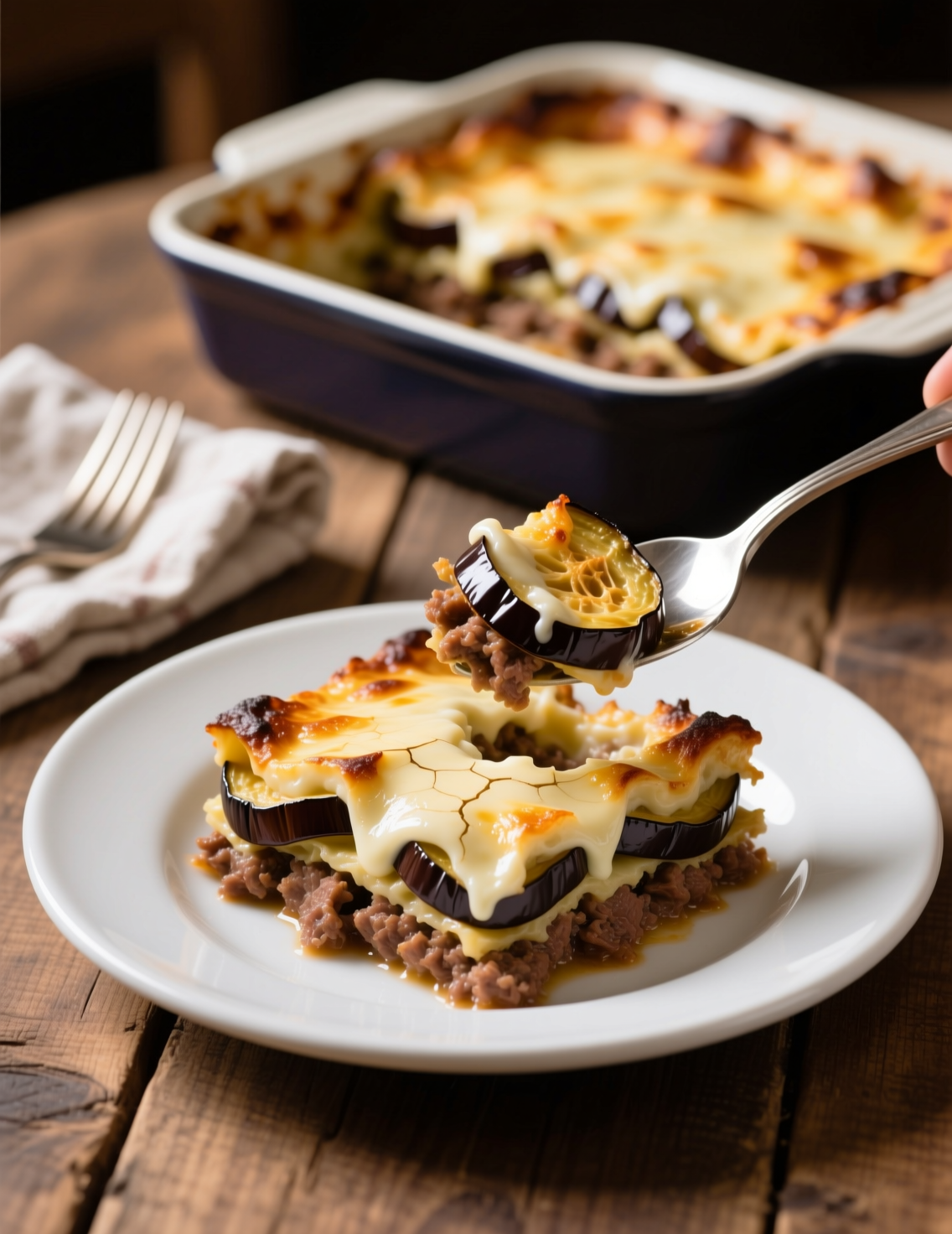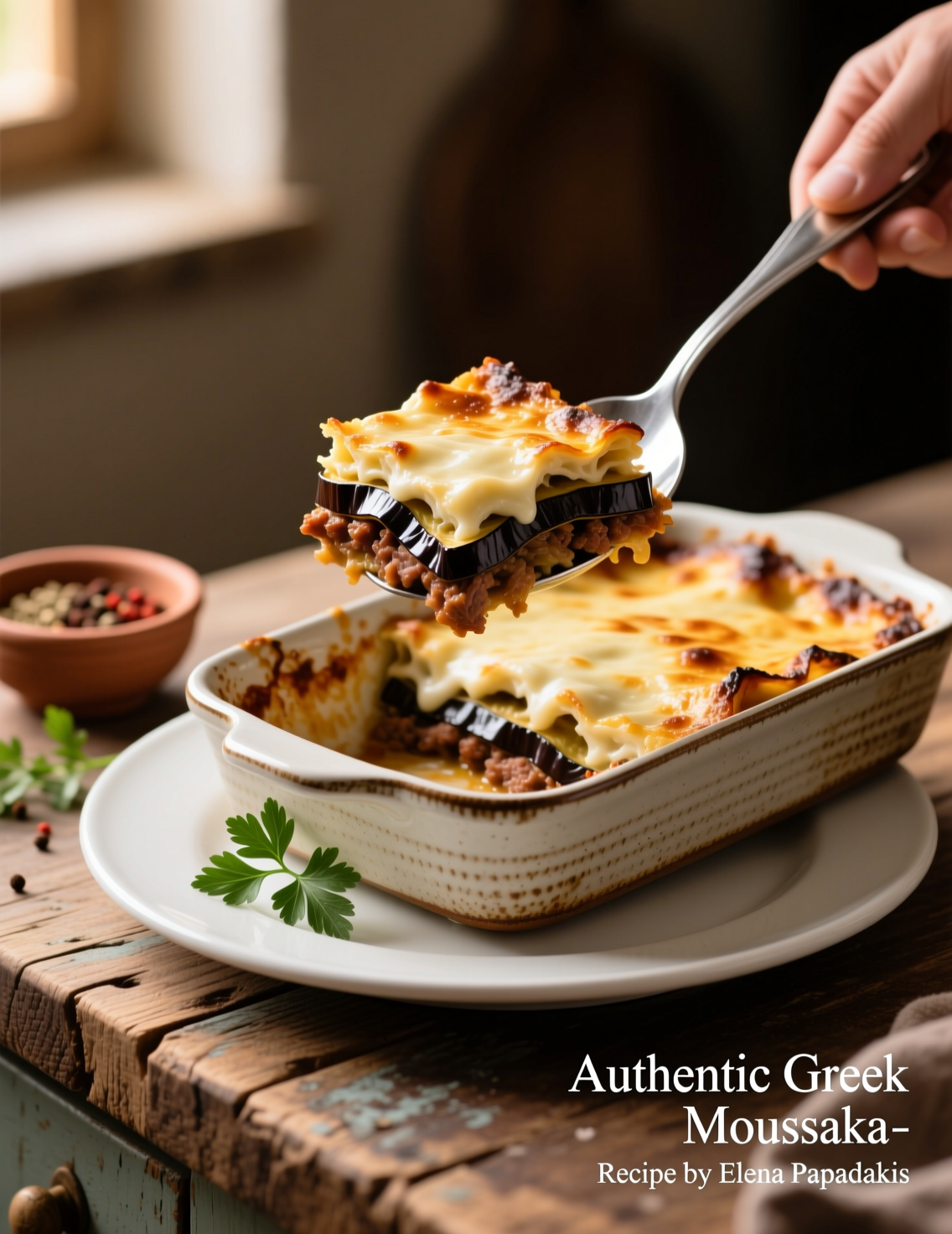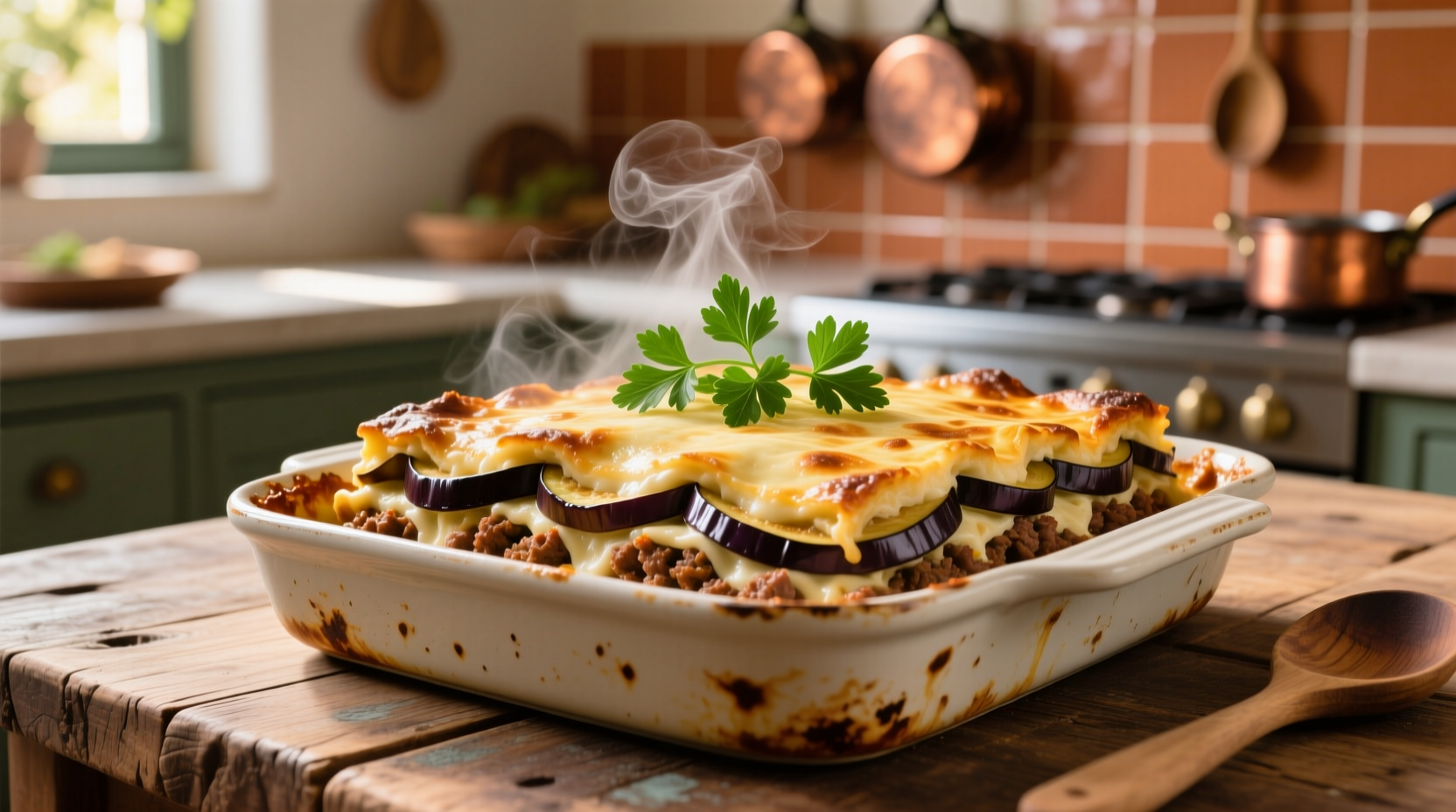There are dishes that simply sit on a plate, and then there are dishes that walk into the room with history strapped to their back. Greek Moussaka belongs to the second group. If you’ve ever wondered what layers of culture, tradition, and precision cooking look like, you’ll find it in this classic eggplant casserole. Professionals know—this isn’t just about roasting vegetables and slapping béchamel on top. It’s engineering, culinary geometry with a Mediterranean soul.
Why Moussaka is Not Just a Dish
Ask any Greek chef, and they’ll tell you straight: moussaka is not dinner, it’s an event. It’s a dish so rooted in Greek kitchens that to cook it without understanding its depth is like playing jazz without knowing scales. The dish reflects Ottoman influences, Venetian refinements, and Greek persistence. Eggplants weren’t even native to Greece until the Arabs introduced them in the Middle Ages. Yet today, moussaka would be unrecognizable without them.
It’s not just layered eggplant with meat and sauce. Every stage, from salting the eggplant to skimming the fat off simmered lamb ragù, determines if you’ll get a dish that whispers authenticity or one that falls apart like wet paper.
Breaking Down the Layers
A professional cook knows moussaka stands on three legs: the eggplant base, the meat sauce, and the béchamel crown. If one of them stumbles, the whole tower collapses.
The Eggplant Foundation
Eggplant is temperamental. Slice it too thick, and you get a soggy bite. Too thin, and it shrivels into oblivion. Tradition calls for half-inch slices, salted generously to pull out bitterness. This isn’t old wives’ nonsense—it’s chemistry. Salt breaks down cell walls and reduces water content, meaning the slices roast instead of steam.
Roasting at high heat, about 425°F (220°C), caramelizes the edges, concentrating sweetness. Frying was once standard, but the grease load is absurd for modern diners, and professionals today lean towards roasting for flavor clarity and structure.
The Meat Sauce: Ragù with Identity
Lamb is the classic choice, beef an acceptable substitute, though less complex. A good ragù for moussaka should remind you of Bolognese but with cinnamon and allspice whispering through the steam. These spices are not optional—they’re the reason Greek kitchens smell the way they do in summer evenings.
The sauce simmers with onion, garlic, tomato paste, crushed tomatoes, and a splash of dry red wine. Here’s where a chef must decide: do you want depth or brightness? Cooking the ragù low and slow for at least 45 minutes gives it depth, like reading a novel slowly instead of scanning headlines. Some chefs even let it cool overnight, claiming the sauce “matures” like wine.

The Béchamel: A Velvet Blanket
French in origin but Greek in spirit here, the béchamel sauce transforms moussaka into something regal. A roux base, milk infused with a touch of nutmeg, and eggs to enrich—it’s delicate work. Get distracted, and you’re left with scrambled egg custard. Professionals often temper eggs into the sauce, whisking furiously like their life depends on it.
For the moussaka topping, the béchamel must be thick enough to stand tall but soft enough to flow gently into the layers beneath. A pinch of kefalotyri cheese, or Parmesan if that’s all you have, sharpens the flavor. This isn’t garnish—it’s structure and bite.
Layering Like a Builder
Here’s where artistry meets craft. The eggplant goes down first, a solid base. Then the meat ragù spreads evenly, sealing into the gaps like mortar. Another layer of eggplant, then another drizzle of ragù if your proportions allow. Finally, the béchamel glides on top, smoothed out like plaster on a wall.
A professional knows not to rush the bake. At 350°F (175°C) for 45–50 minutes, the béchamel sets, turns golden, and the whole dish finds harmony. Cutting into it too soon is a rookie error—the layers need at least 30 minutes of rest. Otherwise, you’re serving a hot, sliding mess.
Recipe: Classic Greek Eggplant Moussaka (Serves 6)
Ingredients
- 3 large eggplants, sliced ½ inch thick
- 2 tsp salt (for purging bitterness)
- 4 tbsp olive oil (plus more for roasting)
- 1 lb ground lamb (or beef)
- 1 large onion, finely chopped
- 3 cloves garlic, minced
- 2 tbsp tomato paste
- 1 can (14 oz) crushed tomatoes
- ½ cup dry red wine
- 1 tsp ground cinnamon
- ½ tsp allspice
- 1 tsp dried oregano
- Salt and pepper to taste
- 4 tbsp unsalted butter
- 4 tbsp flour
- 3 cups whole milk, warmed
- 2 egg yolks
- Pinch of nutmeg
- ½ cup grated kefalotyri or Parmesan cheese
Method
- Salt the eggplant slices and let them drain for 30 minutes. Rinse and pat dry.
- Brush slices with olive oil and roast at 425°F until golden, about 20 minutes.
- For the meat sauce: sauté onion in olive oil until translucent. Add garlic, cook briefly, then stir in tomato paste.
- Add lamb, breaking it apart as it browns. Deglaze with wine. Add crushed tomatoes, cinnamon, allspice, oregano. Simmer 45 minutes.
- For béchamel: melt butter, whisk in flour, cook until golden. Slowly add warm milk. Cook until thick. Temper yolks into the sauce, whisking quickly. Stir in nutmeg and half the cheese.
- Assemble: layer eggplant, then meat sauce, repeat. Top with béchamel. Sprinkle remaining cheese.
- Bake at 350°F for 50 minutes until golden. Rest 30 minutes before slicing.
What Professionals Know That Recipes Don’t Say
A recipe is a map, but professionals know the terrain. Eggplants vary in water content. One batch may require longer roasting, another may burn faster. Trust your senses, not just your timer.
Wine choice shifts the flavor balance. A Greek Xinomavro will cut sharper than an Italian Chianti. Both work, but the dish tells a slightly different story depending on your choice.
Spices are subtle. Cinnamon should hum quietly in the background, not dominate. One extra pinch and suddenly you’re making dessert instead of dinner.
Béchamel thickness is judged by the back-of-the-spoon test. Dip, swipe your finger, and if the line holds, you’re ready. If it drips like soup, cook longer.
Nutrition and Modern Tweaks
A typical serving of moussaka weighs in around 500–600 calories, depending on oil and cheese. Professionals often lighten it by brushing eggplant with oil spray instead of deep frying. Some swap part of the béchamel for Greek yogurt, adding tang and reducing fat.
Vegetarian versions replace the lamb with lentils and mushrooms. While purists roll their eyes, the truth is—it works remarkably well. You keep the earthy base while respecting the layered integrity of the dish.
Common Pitfalls and Fixes
- Soggy Eggplant: Didn’t salt and drain properly. Solution: always purge moisture before roasting.
- Runny Meat Sauce: Sauce wasn’t simmered long enough. Professionals reduce until spoon-drag leaves a trail.
- Split Béchamel: Heat was too high when adding yolks. Solution: temper gently, whisk continuously.
- Collapsing Layers: Didn’t rest after baking. Solution: patience—30 minutes at least.

Moussaka in the Culinary Landscape
Global data from food trend reports show Greek cuisine climbing steadily in popularity. Moussaka sits alongside souvlaki and spanakopita as global ambassadors of Greece’s food identity. For professional chefs, adding moussaka to a menu signals depth and respect for tradition, while offering diners a dish they associate with comfort and authenticity.
In culinary schools, moussaka is taught as an advanced layering dish, much like lasagna but with Mediterranean flair. It demonstrates mastery of béchamel, slow-cooked ragù, and vegetable treatment—a trifecta of techniques every serious chef must master.
Conclusion: Building Respect Through Craft
Cooking moussaka isn’t about throwing ingredients together; it’s about respecting a dish that carries centuries of influence. For six servings, you’re not just feeding six people—you’re passing down a history carved into layers.
If you’re a professional, your role is not only to replicate but to elevate. Roast eggplants until they sing, simmer meat sauces until they whisper secrets, and whisk béchamel like it owes you rent. Do all that, and you don’t just serve moussaka. You serve Greece on a plate, six portions at a time, with pride that even a Greek grandmother would nod at.
FAQs
What is Greek moussaka made of?
It’s a layered dish of roasted eggplant, spiced meat sauce, and creamy béchamel topping.
Can I use beef instead of lamb in moussaka?
Yes, beef works fine, though lamb gives a richer, more traditional flavor.
Why do I need to salt the eggplant first?
Salting removes excess moisture and bitterness, keeping the dish firm not soggy.
How long should I let moussaka rest after baking?
At least 30 minutes, so the layers set and slices hold shape.
What cheese is best for moussaka topping?
Kefalotyri is traditional, but Parmesan makes a good substitute.
Can moussaka be made vegetarian?
Yes, swap the meat for lentils and mushrooms for a hearty version.
How many servings does this recipe make?
The recipe yields 6 generous servings.
What wine pairs best with moussaka?
A Greek red like Xinomavro or a Chianti complements the flavors beautifully.
Can I prepare moussaka ahead of time?
Yes, assemble in advance and bake before serving, or refrigerate overnight.
Is moussaka similar to lasagna?
Yes in structure, but it uses eggplant instead of pasta and Greek spices.

Mariana is a passionate home cook who creates delicious, easy-to-follow recipes for busy people. From energizing breakfasts to satisfying dinners and indulgent desserts, her dishes are designed to fuel both your body and hustle.
When she’s not in the kitchen, she’s exploring new flavors and dreaming up her next recipe to share with the Foodie Hustle community.

